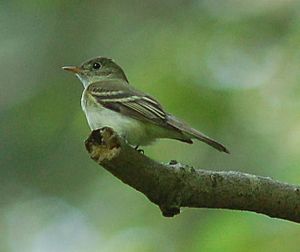Acadian flycatcher facts for kids
Quick facts for kids Acadian flycatcher |
|
|---|---|
 |
|
| Conservation status | |
| Scientific classification | |
| Genus: |
Empidonax
|
| Species: |
virescens
|
 |
|
The Acadian flycatcher (Empidonax virescens) is a small, insect-eating bird. It belongs to the tyrant flycatcher family. These birds are known for their quick movements and unique songs. They live in forests across the eastern United States.
Contents
What Does an Acadian Flycatcher Look Like?
Adult Acadian flycatchers have olive-green feathers on their upper bodies. Their wings and tail are a bit darker. Their undersides are whitish, with a slight olive wash on the chest. They have a clear white ring around each eye. You can also spot white bars on their wings. Their bill is wide, with a dark upper part and a yellowish lower part.
This bird's song is a loud, sudden peet-sa. They also make a soft peet call. Sometimes, they make a sound similar to a northern flicker. A special two-note song, described as "ka-zeep," helps people identify this species. You can also tell them apart by where they live.
Size and Weight
- Length: 5.5 to 5.9 inches (14 to 15 cm)
- Weight: 0.4 to 0.5 ounces (11.1 to 13.9 grams)
- Wingspan: 8.7 to 9.1 inches (22 to 23 cm)
How Was This Bird Named?
The Acadian flycatcher is part of a group of about 15 similar bird species. Long ago, scientists thought all these birds were just one species. This original bird was first found in Acadia, which is now part of Nova Scotia.
Over time, scientists realized these birds were different species. They looked at where the birds lived, their songs, and their habitats. Even though the name "Acadian flycatcher" stuck, this specific bird is not found in Acadia today.
Where Do Acadian Flycatchers Live?
Acadian flycatchers like to build their nests in deciduous forests. These are forests where trees lose their leaves in the fall. They often choose areas near water. You can find them breeding across the eastern United States and in southwestern Ontario.
When winter comes, these birds migrate south. They fly through eastern Mexico and the Caribbean. They travel all the way to southern Central America and the very northwest of South America. This includes parts of Colombia, western Venezuela, and Ecuador.
What Do They Eat?
Acadian flycatchers mostly eat insects. They often wait on a branch in the middle of a tree. When an insect flies by, they quickly fly out to catch it in the air. This is called hawking. Sometimes, they also pick insects from leaves while hovering. This is called gleaning. They might also eat a few berries and seeds.
Nests and Young Birds
These birds build a loose, cup-shaped nest. They usually place it in a horizontal fork of a tree or shrub.
Sometimes, Brown-headed cowbirds lay their eggs in the nests of Acadian flycatchers. However, only a small number of cowbird chicks (about 16%) survive in these nests.
Amazing Fliers
The Acadian flycatcher is an excellent flier. It can move very quickly and change direction easily. It can even hover in the air and fly backward! Scientists don't have much information about these birds hopping or walking on the ground.
Images for kids
See also
 In Spanish: Mosquero verdoso para niños
In Spanish: Mosquero verdoso para niños



